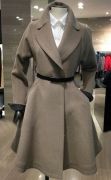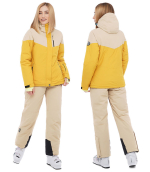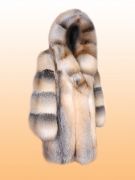Size charts What is the height of the pattern Payment methods Ask a question Reviews

 PDF pattern for printing on a printer or plotter in full size for coat sizes from 40 to 52.
PDF pattern for printing on a printer or plotter in full size for coat sizes from 40 to 52.
The photo shows a variant of a tailored coat according to this pattern from the customer Karlygash Erkegalieva.
How to sew a women's flared coat with a detachable barrel according to this pattern
Sizes: 40-52 (the buyer receives ALL sizes in one PDF file).
File format for download in order:
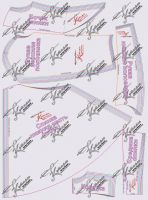 PDF in full size and without seam allowances.
PDF in full size and without seam allowances.
After paying for the order, you will receive links to download two files coat patterns gradation sizes from 40 to 52:
- PDF file A4, adapted for printing patterns on sheets of A4 paper in any program on any device, including mobile phones.
- Multi-format PDF file for printing on sheets of any size from A0 to A4 on a printer or plotter using Adobe Reader.
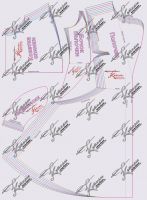 Sewing difficulty level: professional - the pattern is not suitable for beginners, as professional skills in cutting and sewing outerwear are required. The pattern is designed for experienced couturiers specializing in individual tailoring.
Sewing difficulty level: professional - the pattern is not suitable for beginners, as professional skills in cutting and sewing outerwear are required. The pattern is designed for experienced couturiers specializing in individual tailoring.
This coat style is suitable for all types of slim figures.
The consumption of the fabric of the "top" is, depending on the size, 320 - 350 cm with a width of 140 cm and maintaining the length of the product (Du \u60d 200 cm). The lining consumption, excluding the back yoke, is about 130 cm. The doubler will need about XNUMX cm.
Please note that fabric consumption is approximate. For an accurate calculation of the fabric, you should know its exact width (138, 140 or 150 cm) and perform a preliminary layout, taking into account the desired length.
 Of the equipment, except for an iron or a steam generator, a mannequin is required. Homemade mannequins from adhesive tape DO NOT SUIT!
Of the equipment, except for an iron or a steam generator, a mannequin is required. Homemade mannequins from adhesive tape DO NOT SUIT!
For sewing a flared coat with a detachable barrel, almost all soft coat fabrics of thin and medium thickness are suitable. The ideal option for this style would be lightweight drape or tweed. Dense rigid fabrics such as cloth and thick fabrics with a long pile of the "beaver" type are not suitable. Women's platinum can be a little heavy for flares, and men's platinum is not even worth considering.
See also what to make a coat
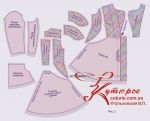 The set of patterns for a flared coat with a detachable barrel includes (picture 1):
The set of patterns for a flared coat with a detachable barrel includes (picture 1):
back patterns - yoke, middle, side, lower part (skirt) and flying yoke;
shelf patterns - the shelf itself and the side of the shelf;
patterns of a two-seam sleeve - upper and lower halves,
as well as a collar.
 Lining patterns are not included in the set of patterns, but below are explanations of how to cut out a lining without a pattern.
Lining patterns are not included in the set of patterns, but below are explanations of how to cut out a lining without a pattern.
How to print a pattern life-size at home on A4 sheets
How to choose a pattern size without taking measurements and using tables
Download free patterns of dresses and coats for children
Buy and download this coat pattern
 How to cut and how to sew a flared coat with a detachable barrel at home
How to cut and how to sew a flared coat with a detachable barrel at home
Attention! Sewing a coat of this style has a lot of nuances and requires well-developed skills, so it is not suitable for learning to cut and sew.
Let's start with seam allowances and the fractional direction of the thread in the details of the cut (picture 2).
Most seam allowances are 1 - 1,5 cm. The exceptions are the cuts of the eyelet, armhole, sprout and neckline - no seam allowances are added for them. According to the departure of the lower collar, it is reasonable to add 0,7 cm to the seams, and according to the departure of the lower collar - 1 - 1,2 cm, depending on the thickness of the material. The same applies to the edge of the lapel - the lapel of the shelf - 0,7 cm, the lapel of the selection - 1 - 1,2 cm.
 We add 3-4 cm along the bottom of the product, 3 cm along the bottom of the sleeve. If you need a lapel, add it at will. Optionally, an additional allowance for the elbow seam can be added if you want to process an open slot in the style of a classic sleeve slot.
We add 3-4 cm along the bottom of the product, 3 cm along the bottom of the sleeve. If you need a lapel, add it at will. Optionally, an additional allowance for the elbow seam can be added if you want to process an open slot in the style of a classic sleeve slot.
The cutting of the shelves requires special attention, since the selection in this coat (as in other products with a straight line of the side) is combined. The lower part of the selection is one-piece, and the upper part is detachable.
The recommended width of the single-cut part of the selection for a single-breasted coat is 10-11 cm. This is if the half-skid is 3,5-4 cm from the line of the edge of the side.
It is worth noting that it is extremely important to place the seam of the connection between the facing and one-piece parts of the selection between the loops.
As you can see from the model, the fastener is hidden here, but the location of the loops is still important. If the coat is to be worn WITHOUT a belt, then a loop at the waist is obligatory and a loop at the base of the lapel fold is desirable. If the coat is worn with a belt, then only a loop at the base of the lapel fold is required, but it should not be around the waist.
 When cutting out the combined pick, do not forget to add a 1 cm seam allowance at the junction of the facing and one-piece parts.
When cutting out the combined pick, do not forget to add a 1 cm seam allowance at the junction of the facing and one-piece parts.
In addition, you will need a notch in the corner of the ledge of the one-piece bead - see picture 2.
See more about how to cut and sew combined boards
See also dubbing and processing of various types of boards
A few words about dubbing (drawings 2 и 3), which is cut out according to the same patterns as the details of the "top" WITHOUT seam allowances.
Back: duplicate the yoke, the middle of the back and the side.
The shelf is duplicated to the waist and cut out with “teeth”. Having a "rocking" lapel, we duplicate the top of the shelf completely, without making an "indent" for the kink. Both the barrel and the details of the selection are completely duplicated. Of course, we duplicate the lower and upper collars.
And after processing the side seams, you can duplicate the bottom of the coat. The bottom of the sleeve is duplicated after the WTO and the processing of the front seam.
You can write about the nuances of duplication for a long time, but let's move on to cutting.
 To begin with, this is a very uncomfortable style in the layout, starting with medium sizes. If you are lucky and you buy a fabric with a width of 150 cm, and the size you need is 40 or 42, then you simply fold the fabric in half lengthwise, aligning the edges.
To begin with, this is a very uncomfortable style in the layout, starting with medium sizes. If you are lucky and you buy a fabric with a width of 150 cm, and the size you need is 40 or 42, then you simply fold the fabric in half lengthwise, aligning the edges.
But, if the width of the fabric is 138 - 140 cm and the size is from 44th, and you want to keep the length, cutting will become much more complicated (picture 3) and my explanations will be useful to you.
We fold the fabric in half face to face, combining the edges and making a fold Across the fabric. The fold is placed so that the shelf runs along the length - the scheme of the fold of the fabric in the bubble. Then, we arrange, taking into account the desired share direction, all paired parts.
Let me remind you the importance of the lobar direction for the upper half of the sleeve - the lobar passes through the upper and lower points of the front seam. For the facing part of the selection, in most cases, the share runs parallel to the edge of the lapel, and in the lower collar - parallel to the rake.
The lobar middle of the back is perpendicular to the waist line. Barrels and the lower half of the sleeve are not so "demanding" to the observance of the share direction, so small deviations are allowed.
Separately, it is worth talking about flared details - the lower part of the back and the flying yoke. Before cutting them, you should think about what is more important, savings or beauty. Contrary to popular belief, the middle line of flared parts should go along an oblique, and not along a shared thread. If the middle line of the flared “skirt” is shared, then its sides will soon stretch out and the bottom will deform. This is less noticeable on the flyaway yoke, so it can be cut both along the lobar and along the oblique thread.
In conclusion, about the yoke and the upper collar. You can save money on a yoke by doing it with a middle seam, but it’s not worth it on the upper collar - it should be one-piece. The share coincides with the middle line.
Now the most interesting thing - we cut the lining (picture 4). We do this for the product after processing the back, shelves and sides, and, therefore, this happens after the first fitting. The sleeve has a front seam.
When cutting the lining, we can easily reduce consumption by laying back and front flares in conical warehouses. When cutting the lining, do not forget to lay darts at the waist and chest tuck from the armhole. All these darts are best handled as soft warehouses. It is also important that the lining of the shelf go to the pick-up by 2 - 3 cm, that is, the width of the double allowance.
Then, taking into account all of the above, it remains only to circle the parts of the “top” on the lining fabric (picture 5).
Acceptable layout - "Jack". Sleeve - across for economy. On the middle seam of the back, take into account the allowance for the tuck slot in the area of the shoulder blades.
Download this pattern pdf:
Pattern "flared coat with a detachable barrel"
$3.00 (120 hryvnia)
Bank cards of the Russian Federation are not accepted for payment!
Size charts What is the height of the pattern Payment methods Ask a question Reviews
Vera Olkhovskaya in social networks:

-
Any pattern for free for a review of a previously made order
More...
Lifetime promotion for buyers of patterns!

Leave a review about my store of patterns for an order that you made before, and you will receive any paid pattern of your choice Free!
